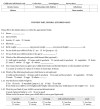Prevalence and influencing factors of obesity in preschool children in Suzhou, China
- PMID: 40304416
- PMCID: PMC12121459
- DOI: 10.23938/ASSN.1105
Prevalence and influencing factors of obesity in preschool children in Suzhou, China
Abstract
Background: The study aims to assess the prevalence of obesity among preschool children in Suzhou, China, and analyze potential risk factors to the condition.
Methods: The study included preschool children aged 3-6 from various kindergartens in Suzhou. Height and weight measurements were used to determine obesity status, while parents completed questionnaires on relevant information. The Chi-square test was applied to compare obesity rates across groups, and stepwise logistic regression analysis identified associated risk factors for obesity.
Results: Eight hundred and forty-eight preschoolers participated. The overall obesity prevalence was 14.0%, with 4.0% categorized as moderately obese (and 7.5% as mildly obese. Boys had a higher obesity prevalence than girls (15.3% vs. 12.7%), and rural children higher than urban children (17.2% vs. 13.1%), although these differences were not statistically significant. Obesity was most prevalent among 3-year-olds (16.1%) and least prevalent among 6-year-olds (11.2%). Logistic regression identified age (boys: OR=0.30; 95%CI: 0.19-0.38, girls: OR=0.24; 95%CI: 0.17-0.36), height (boys: OR=1.21; 95%CI: 1.16-1.26, girls: OR=1.25; 95%CI: 1.18-1.38), and urban location (boys: OR=0.60; 95%CI: 0.34-0.86, girls: OR=0.48; 95%CI: 0.31-0.84) as significant independent predictors for obesity in preschool children in Suzhou, China.
Conclusions: The obesity rate among preschool children in Suzhou is 14.0%. The study highlights lower age, higher height, and rural location as important factors influencing obesity in both sex.
Fundamento:: El objetivo es evaluar la prevalencia de obesidad entre preescolares de Suzhou (China) y analizar su relación con diferentes factores.
Métodos:: En el estudio participaron niños de 3 a 6 años de edad de varios jardines de infancia de Suzhou. Se midieron la altura y el peso para determinar el estado de obesidad, y los padres rellenaron cuestionarios para obtener información relevante sobre estilos de vida. Se compararon las tasas de obesidad mediante Chi-cuadrado y el análisis de regresión logística por pasos identificó los factores de riesgo asociados.
Resultados:: Participaron 848 preescolares. La prevalencia global de obesidad fue del 14,0%: 4,0% de moderada y 7,5% leve. La prevalencia de obesidad fue mayor en niños (15,3% frente a 12,7%) y en zonas rurales (17,2% frente a 13,1%), aunque con diferencias estadísticamente no significativas. La obesidad fue más prevalente a los 3 años (16,1%) y menos prevalente a los 6 (11,2%). Tanto en niños como en niñas, la edad (OR=0,30; IC95%: 0,19-0,38 y OR=0,24; IC95%: 0,17-0,36), la altura (OR=1,21; IC95%: 1,16-1,26 y OR=1,25; IC95%: 1,18-1,38) y la zona urbana/rural (OR=0,60; IC95%: 0,34-0,86 y OR=0,48; IC95%: 0,31-0,84) resultaron predictores independientes de obesidad en preescolares de Suzhou, China.
Conclusiones:: La tasa de obesidad entre preescolares de Suzhou es del 14,0%. Menor edad, mayor estatura y residir en zona rural fueron identificados como predictors independientes de obesidad en ambos sexos.
Conflict of interest statement
Figures





References
MeSH terms
LinkOut - more resources
Full Text Sources
Medical

